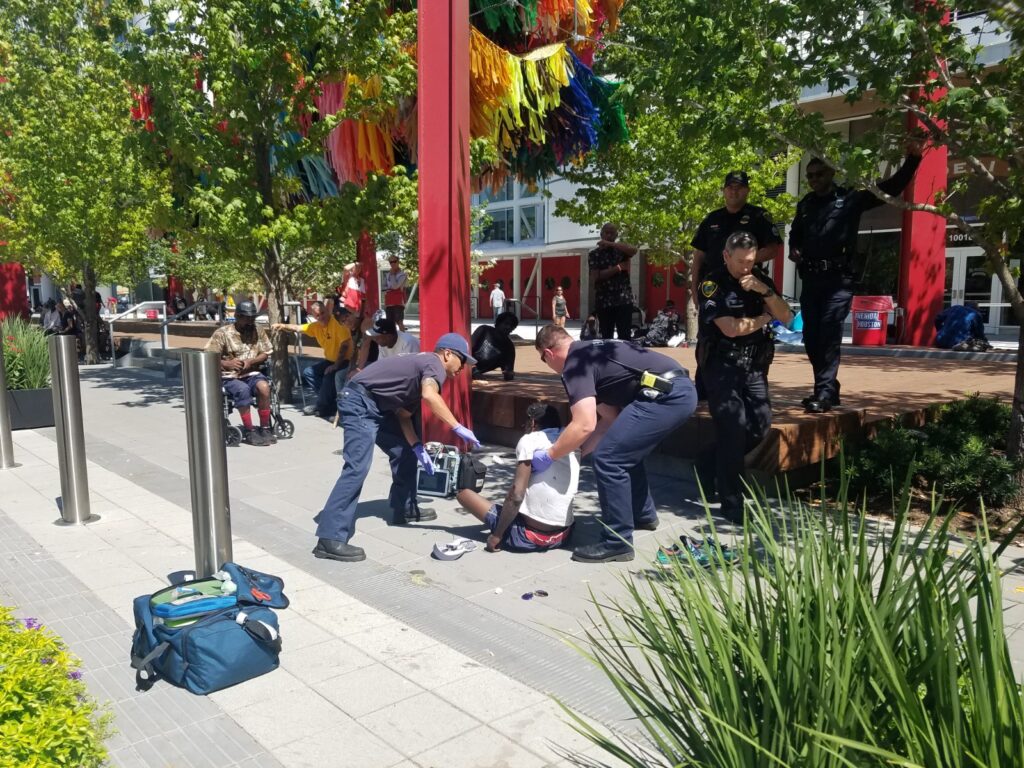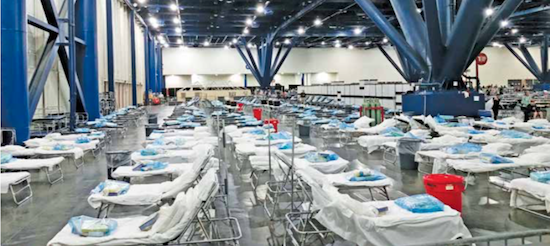By Christina Shibu

Houston Fire Department EMTs administer aid to a Hurricane Harvey evacuee in front of the George R. Brown Convention Center shelter. Emergency medical personnel and doctors treated patients for many different issues from dehydration to mental health issues and chronic illnesses. Photo courtesy of Diana J. Rodriguez.
One week in the latter half of August 2017, Houstonians witnessed two vastly different sides of nature. On August 21, as schools resumed classes, adults and students alike were awed by the solar eclipse that occurred that day. Four days later, Hurricane Harvey made landfall at Port O’Connor, Texas, and forever changed the lives of Houstonians.
In many ways response to Hurricane Harvey reflected the city’s communal spirit. As residents were rescued from their flooded homes and moved into shelters, city health officials managed public health needs, hospital treatment, and disease prevention. While many shelters provided refuge to evacuees, the George R. Brown Convention Center (GRB) unexpectedly became a mass shelter on Sunday, August 27, housing approximately 11,000 residents over a twenty-two- day period and providing them a much needed lifeline.
The city’s original plan for a storm emergency involved “work[ing] with the American Red Cross and a number of other community partners to have large shelters set up around the city,” explained Dr. David Persse who serves as physician director for the Houston Fire Department Emergency Medical Services (HFD EMS) and as the public health authority for the City of Houston. Overseeing disaster preparedness in both of his roles, Dr. Persse observed, “When Harvey hit, those shelters all stood up exactly ac- cording to plan … except they filled up almost immediately.”

with acute medical needs.
Photo courtesy of the Center for Disease Control.
As a result, even though the city had used the convention center as a shelter in the past and planned never to do so again, circumstances forced officials to convert GRB to a shelter, despite the fact it had “no cots [and] no supplies for disaster preparedness.” Dr. Persse emphasized, “The disaster doesn’t read your plan ahead of time. You find that your plan never matches exactly your needs. But if you understand your assets, whether it be a piece of equipment or a concept in a plan, … you will be able to then apply it, perhaps in a twisted, changed fashion, to meet the need that you have during the actual disaster.” This philosophy captures how GRB functioned during Hurricane Harvey. Intended to accept 5,000 evacuees, it took in more than twice that number.
Once the City of Houston decided to activate the temporary shelter at GRB, organizations like EMS used all the tools at their disposal to open it. Emergency medical professionals come into a disaster equipped with assets such as training, experience, and departmental resources to pre- pare for multiple types of scenarios. Additionally, all EMS healthcare providers and first responders participate in mock drills, so that they enter a disaster zone equipped with the skills and knowledge to serve those in need.
Click here to read the full article or click on Buy Magazines to purchase a print copy or subscribe.

To learn more about the Houston Fire Department, visit the HPDMD website here.

The Disaster medical Assistance Teams created a posted dedicated to informing how civilians can access medical care during large-scale here.
went above and beyond in the aftermath of Harvey.

 Follow
Follow